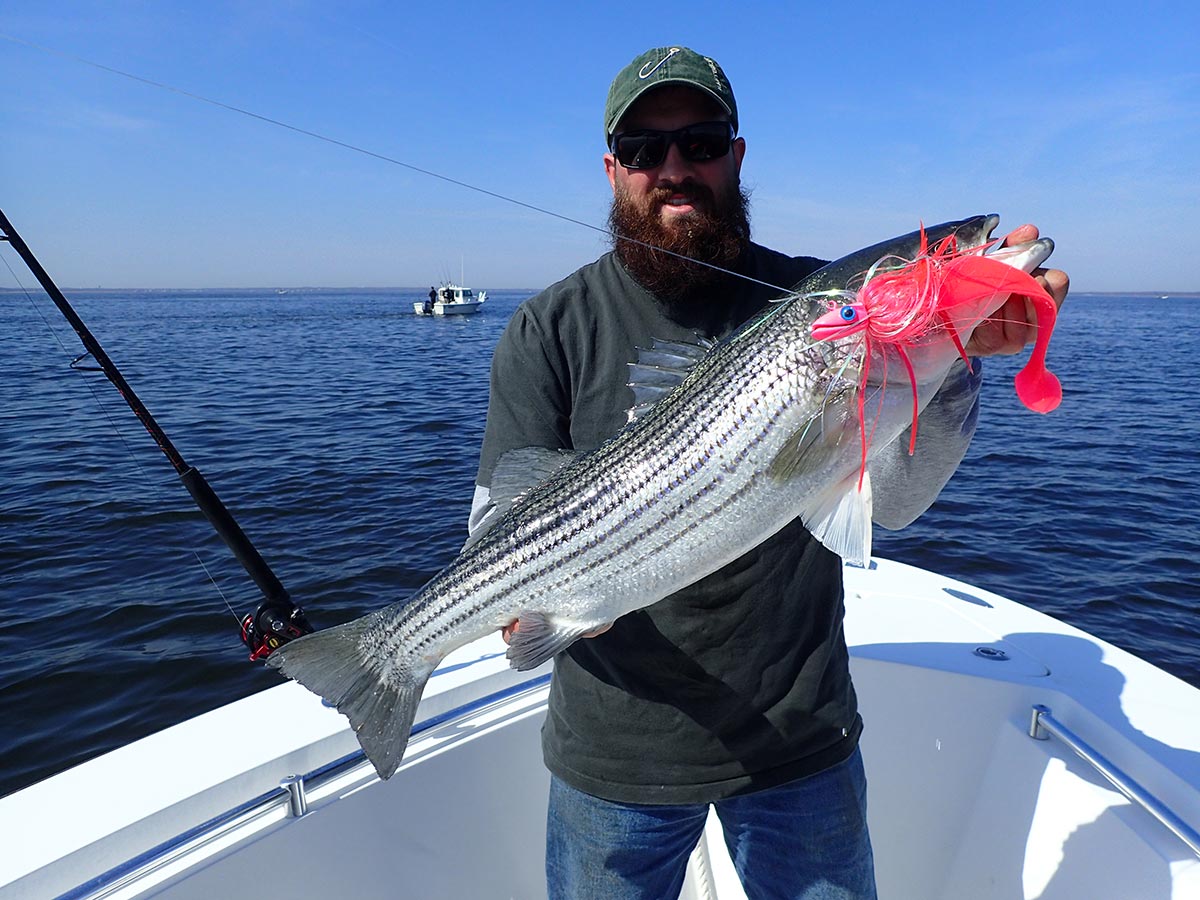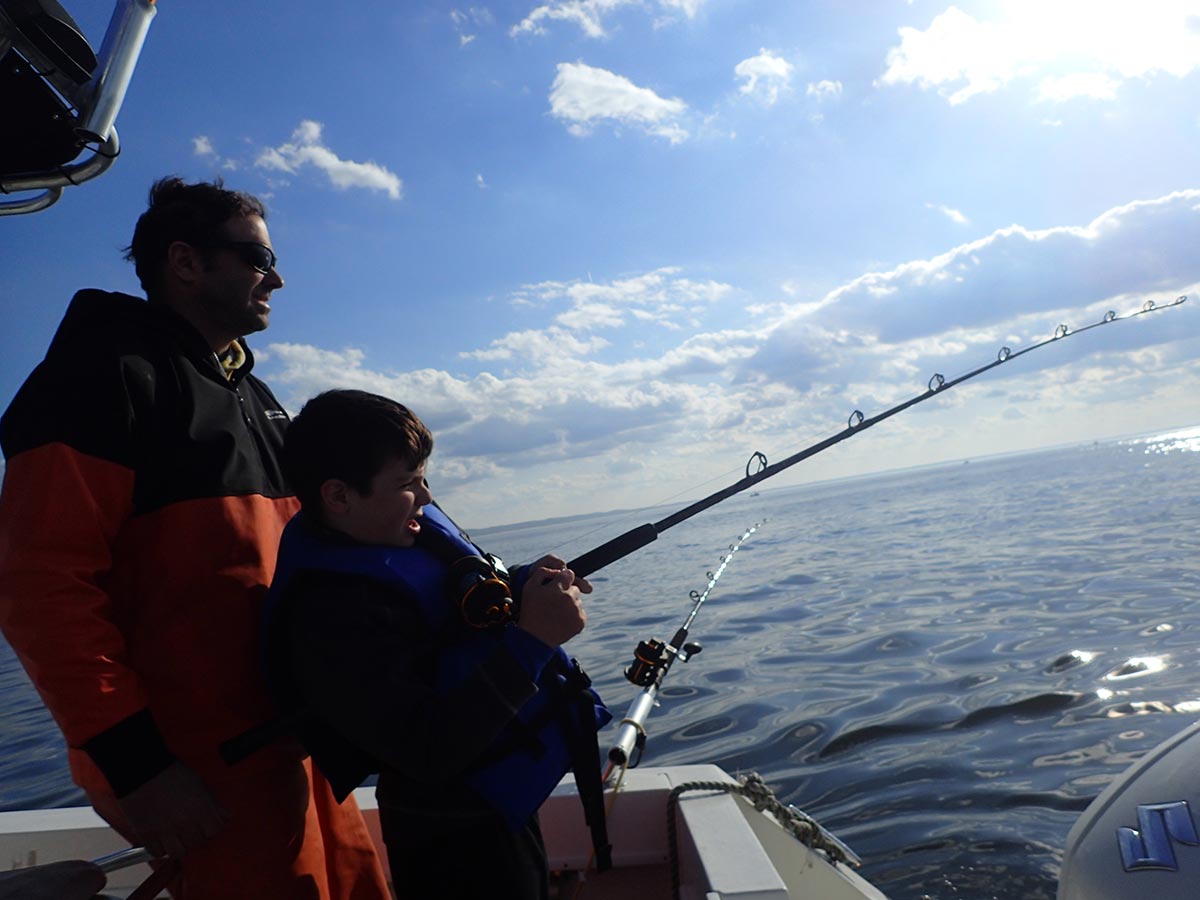
Fish on, but don’t clear those other lines just yet!
Many would argue that trolling is the most effective way to locate, then tally high numbers of striped bass. Different portions of the water column and overall depth can be covered, all while baits are presented without interruption.
That said, for anglers that really love jacking their stat line, there is a way to substantially enhance the amount of strikes by stripers of all sizes. When a fish is hooked up for example, the captain and crew should not clear the other lines in order to fight the hooked up bass. Rather, the trolling speed should be maintained, while the fish pulls drag. On many days when fish are abundant, the results of leaving them in can be staggering. Striped bass sometimes migrate as individuals, however, they most often swim in schools. Those schools can be small and have even been termed “wolfpacks” because their numbers are on the lighter side. But bass also travel in gigantic schools, especially when the larger stocks are migrating together. Odds are when a striped bass is hooked, it’s probably not the only one in the immediate area. The fighting bass itself can draw attention from ravenous and curious cousins. If lines are completely cleared there’s no chance to get the additional hits.
As the line races off one reel after the initial strike, keep the boat at the same speed as when the pick-up was made. First, the boat still cruising at trolling speed with the fish swimming hard in the opposite direction will bury the hook in the fish’s mouth most of the time. Second, it will give additional stripers a chance to see the bait presented at a speed that produced the best wiggle of the lure.
Consider the paddletails and the umbrellas undulating on the mojos, or the pulsing of the rod while bunker spoons move from side to side. If the bite is “sensitive” on a given day, those moments of holding the vessel at the same speed can be vital to getting the extra bite. Striped bass aren’t like a mahi or sailfish that will dart laterally across the spread so tangled lines aren’t an immediate concern. At least not right away.
Obviously, if a second strike does not take place after about five to ten seconds of staying at trolling speed, the captain will drop down to his preferred fish-reeling speed. Some captains clear lines and go into idle. Personally, I never do that. Often the hooked fish swims to the boat and tension can be lost resulting in losing pressure, which can lead to a drop. Instead skippers can keep the boat at speeds just above idle or bump the boat in and out of idle in order to keep the vessel moving and lines tight! When moving at these slower speeds in order to land a fish, the other mojos and spoons will sink to the bottom where they will gather mud or even get snagged. Adjustments have to be made lickity-split! If I’m alone, I’ll reach over and crank the lures off the bottom with one hand grasping the rod with the fish and one getting the lures up. If I have a crew, it’s much easier and everyone can reel the lines up to the middle of the water column.

Yes, I leave the lines in even at a slow speed and they lay-out in various heights mid-water column. There, they have ample opportunity to get hammered by approaching bass all while the hooked bass is getting reeled in. Sometimes this technique garners two, three, four, five, six, seven or even eight fish at once! If I’m running four tandem mojos, I’ve had fish on all four tandems! It can get absolutely crazy.
There are negatives, of course. When a fish is hooked with lines still in the water, anglers need to be ready to pass a rod above or below another line depending on where the bass comes up. As the fish approaches the stern, it’s not uncommon for this necessity. Everything has to be accomplished with a little more chaos if multiple fish are hooked. And tangles can occasionally take place although with experience, they are minimized.
The positives? Huge numbers of fish landed and released unharmed. Trolling for bass lends itself to extremely low mortality numbers due to fish only being hooked in the mouth region. “Personal best” bass getting more looks at the spread is an absolute attribute of keeping them in. And finally, if there are a bunch of guys or gals waiting to get on the reel, more opportunities certainly go in the plus category.




